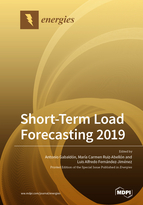Short-Term Load Forecasting 2019
A special issue of Energies (ISSN 1996-1073). This special issue belongs to the section "A1: Smart Grids and Microgrids".
Deadline for manuscript submissions: closed (31 March 2020) | Viewed by 54202
Special Issue Editors
Interests: analysis of electrical distribution systems; electricity markets; demand response; energy efficiency; electric haulage in railways and non-invasive monitoring techniques
Special Issues, Collections and Topics in MDPI journals
Interests: forecasting techniques; machine learning; time series analysis; entropy measures; energy markets
Special Issues, Collections and Topics in MDPI journals
Interests: electricity markets; energy forecasting models; power systems planning; renewables; grid integration of distributed energy systems
Special Issues, Collections and Topics in MDPI journals
Special Issue Information
Dear Colleagues,
It is well known that short-term load forecasting (STLF) plays a key role in the formulation of economic, reliable, and secure operating strategies for power system (planning, scheduling, maintenance, and control processes, among others), and this topic has been an important issue for decades. However, there is still so much to do in this field. The deployment of enabling technologies (e.g., smart meters) has made high granular data available for many customer segments and for many tasks, for instance, to make feasible load forecasting tasks at several demand aggregation levels. The first challenge is the improvement of the STLF models and their performance at new demand aggregation levels. Moreover, the increasing inclusion of renewable energies (wind and solar power) in the power system, and the necessity to include more flexibility through demand response initiatives have introduced greater uncertainties, which means new challenges for STLF in a more dynamic power system in the near future.
Many techniques have been proposed for STLF, including traditional statistical models (such as SARIMA, ARMAX, exponential smoothing, linear and non-linear models, etc.) and artificial intelligence techniques (such as fuzzy regression, artificial neural networks, support vector regression, tree-based regression, ensemble methods, stacked methods, etc.). Furthermore, distribution planning needs, as well as grid modernization, have initiated the development of hierarchical load forecasting. Analogously, the need to face new uncertainties sources in the power system, has given more importance to probabilistic load forecasting in recent years.
This Special Issue is concerned with both the fundamental research on STLF methodologies and practical application research, in order to face the future challenges of a more distributed power system in the future.
All of the submitted contributions must be based on the rigorous motivation of the mentioned approaches, and demonstrate a theoretically sound framework; submissions lacking such a scientific approach are discouraged. It is reccomended that existing/presented approaches are validated using real practical applications.
Prof. Dr. Antonio Gabaldón
Prof. Dr. Dr. María Carmen Ruiz-Abellón
Prof. Dr. Luis Alfredo Fernández-Jiménez
Guest Editors
Manuscript Submission Information
Manuscripts should be submitted online at www.mdpi.com by registering and logging in to this website. Once you are registered, click here to go to the submission form. Manuscripts can be submitted until the deadline. All submissions that pass pre-check are peer-reviewed. Accepted papers will be published continuously in the journal (as soon as accepted) and will be listed together on the special issue website. Research articles, review articles as well as short communications are invited. For planned papers, a title and short abstract (about 100 words) can be sent to the Editorial Office for announcement on this website.
Submitted manuscripts should not have been published previously, nor be under consideration for publication elsewhere (except conference proceedings papers). All manuscripts are thoroughly refereed through a single-blind peer-review process. A guide for authors and other relevant information for submission of manuscripts is available on the Instructions for Authors page. Energies is an international peer-reviewed open access semimonthly journal published by MDPI.
Please visit the Instructions for Authors page before submitting a manuscript. The Article Processing Charge (APC) for publication in this open access journal is 2600 CHF (Swiss Francs). Submitted papers should be well formatted and use good English. Authors may use MDPI's English editing service prior to publication or during author revisions.
Keywords
- short term load forecasting and distributed energy resources
- short term load forecasting and demand aggregation levels
- statistical forecasting models (SARIMA, ARMAX, exponential smoothing, linear and non-linear regression, and so on)
- artificial neural networks (ANNs)
- fuzzy regression models
- tree-based regression methods
- stacked and ensemble methods
- evolutionary algorithms
- deep learning architectures
- support vector regression (SVR)
- robust load forecasting
- hierarchical and probabilistic forecasting
- hybrid and combined models






